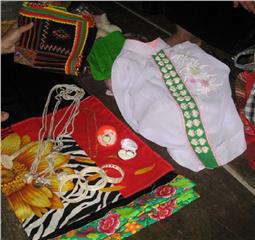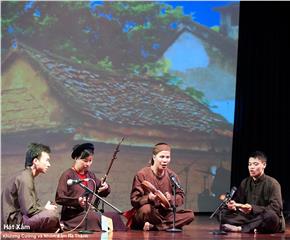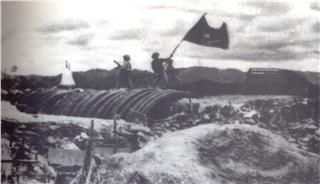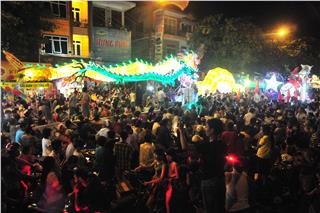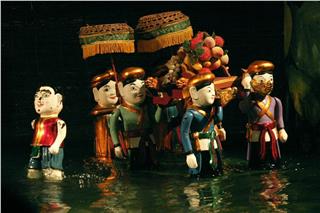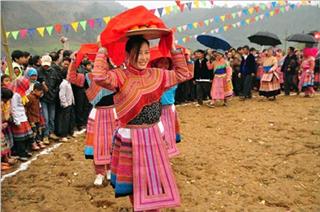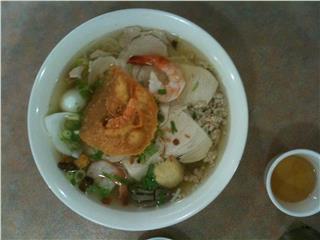Enchanting Khen sound of Hmong people
Fri, 08 Aug 2014 . Last updated Thu, 25 Jun 2015 08:47
-
 Vietnam – The S-shaped country 10092 viewed
Vietnam – The S-shaped country 10092 viewed -
 Ancient Vietnamese coins – Episode 1 9425 viewed
Ancient Vietnamese coins – Episode 1 9425 viewed -
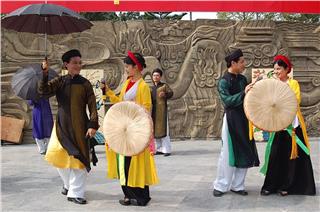 Special cultural features of Quan Ho singing 8586 viewed
Special cultural features of Quan Ho singing 8586 viewed -
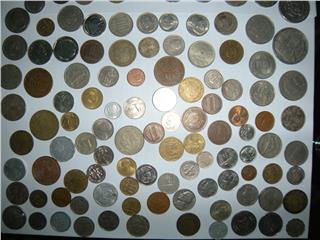 Ancient Vietnamese coins – Episode 2 8399 viewed
Ancient Vietnamese coins – Episode 2 8399 viewed -
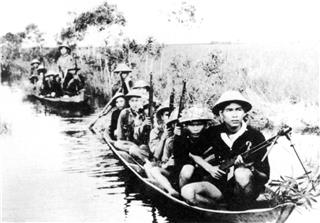 Vietnam History 1858-1945 7168 viewed
Vietnam History 1858-1945 7168 viewed -
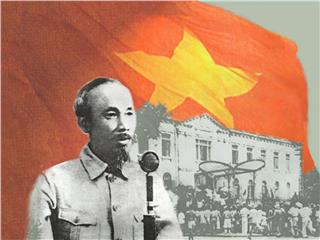 The Vietnamese Proclamation of Independence 6690 viewed
The Vietnamese Proclamation of Independence 6690 viewed -
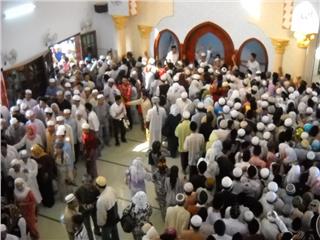 Cham Muslims in An Giang 6123 viewed
Cham Muslims in An Giang 6123 viewed -
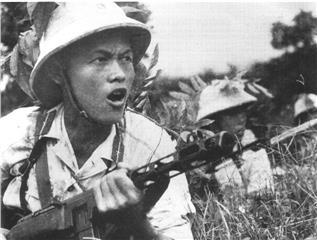 Vietnam history 1945-1954 6002 viewed
Vietnam history 1945-1954 6002 viewed -
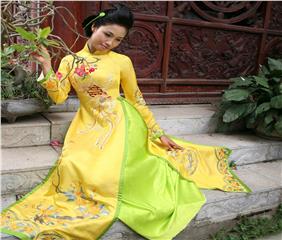 Predestined love tie with Ao Dai - Vietnamese long dress 5706 viewed
Predestined love tie with Ao Dai - Vietnamese long dress 5706 viewed
For the Hmong people, the khen sound is a dispensable thing in their life. The “khen” of Hmong has unique features making the Hmong identity. Its sound not only wins the hearts of most Hmong people, but also captivates those who once enjoyed.
As told by the elderly people, there was a family with 6 brothers. They could play “khen” well. Each person had a “khen”. When they were happy or sad, they played “khen”. One day, the youngest brother wanted to make a musical instrument so that 6 brothers could play together. If one of 6 brothers died or were absent, how can blow well? So he used a big gourd and attached 6 bamboo tubes on it to make a “khen”. The tubes symbolized 6 brothers, the longest one for the eldest brother and the shortest one for the youngest brother. When attached together, one person can blow and the sound of the 6 tubes was good. The “khen” of Hmong people was born like this. The “khen” sound has long been the spiritual food, the cultural identity of the Hmong people. It is played in funerals, weddings or festivals. The “khen” sound is part of the mountainous area. The “khen” sound carries words of love of young couples and the spring vitality of the mountainous area.
The Hmong ethnic group in Vietnam has 5 branches: the white Hmong, the Mong Hoa, the Red Hmong and the Blue Hmong people. The Hmong people usually reside on the hills at the attitude of 800 meters – 1500 meters above the sea level. They have a liberal life and love nature. The village of the Hmong people is always filed with the sweet sound of “khen” as the melody of the life in the mountainous area. Houses of the Hmong people look like bird nests on the slopes. The road to the village is meandering. The hard weather has created their strong personality. They have together grown corn in the poor soil. The corn grows from their sweat.
They bring “khen” to the fields with them to dispel the tiredness among the wild mountains. The “khen” sound is like human voice. The life of the Hmong people is calculated by the corn seasons. They live on the nature, so that they have enough food to eat when they have a bumper crop, sometimes they have a poor crop. The “khen” is always by their side in any circumstance. The “khen” sound echoes by the fire warming their heart.
The “khen” sound is the sound of mountains and forests, expressing the liberal soul of the Hmong people. It has long been the means carrying words of love of Hmong boys and girls. That sound has penetrated into veins of the Hmong people. It is a part of their soul. Keeping the “khen” sound means keeping the identity of their ethnic group. The Hmong people have a saying: those who can play “khen” are allowed to drink wine. That is show the important position of “khen” in their life. Every Hmong man, old or young, always brings “khen” along with them. Through the “khen” sound, we can know the physical strength and the spiritual life of the player. The Hmong people are proud of their “khen” and “khen” dance.
Now the ethnic minorities in the Northwest or the Central Highlands rarely bring musical instruments with them when going out, it is used just in festivals. However, the Hmong people always bring “khen” along with them. They consider it a decorative and scared thing that protects them. It is closely attached to their daily life and spiritual activities. They bring it with them like a sacred thing.
The “khen” sound of this Hmong man is still strong as when he was young. Though he is now more than 60, Trang A Lu (Van Ho – Son La) still keeps in his mind the pieces of “khen” that he has played and learned from ancestors. He started playing “khen” at the age of 7-8. For him, it was not easy to play “khen”. Everyone can learn how to play but only the people with good memory can play a tune. Only 1 to 2 people among 100 of them can do that. So playing “khen” well is the pride of any Hmong man.
Today when coming to Son La and listening to the “khen” sound of the Hmong people – the sound of the mountains and forests, I want to hold a “khen” in my hands and try playing it. Fortunately, artisan Trang A Lu agrees to teach me.
What is the first stage to learn how to play “khen”? You play this “khen”, I will press it for you to play. Then you put your fingers here. I play first, then you play and I press it.
I start learning the basic techniques of playing “khen”. As said by Lu, to play “khen” of the Hmong people, the learner must experience 3 stages: take a breath, play in tune and learn to dance. Experiencing 3 basic stages, the Hmong man can play “khen”.
- Artisan: You have tried playing “khen”. Now sit down and put our fingers on ours.
- Guide: Like this?
- Artisan: Put your 6 fingers here and play.
It takes many years for the Hmong men to be able to play a traditional tune of “khen”. Artisan Lu says to play “khen” well the learner must have thorough understanding of it. He says, it is a wrong thinking that the Hmong men played “khen” to “conquer” a girl’s love. In fact, they played “khen” in funerals to show their love and pity to the dead and the community activities to show their strong determination. It takes a person at least 3 years to be able to play “khen” well. For me, today I just learn to familiarize myself with “khen” and its sound. It is enough to make me interested in this unique musical instrument.
- Guide: How do we move while playing “khen”?
- Artisan: You follow what I have taught you. When you can play “khen” pretty well, you start learning how to dance. The uique feature of “khen” is to have a dance together. Let’s see me. Without a guest, I dance alone. When the guest comes, I receive him. He goes that way. When the guest is coming, I dance.
To suit the harsh weather of the mountainous area, the “khen” sound of the Hmong men is as strong and liberal as their life. Its sound has deeply penetrated into their veins like the traditional dish “men men” (a specialty of the Hmong ethnic people made of mainly maize).
Different clans of the Hmong people worship different deities. For example, the white Hmong people and the Mong Hoa people worship a same go, a “khen” master, a kind of “khen”. The Black Hmong people also use this kind of “khen” but a different master. As told by the elderly, when the Mong Hoa and White Hmong people went home from the “khen” class, they saw a muntjac caught in a trap. The god said them that they should do like that muntjac did. The munjac jumped 3 rounds on tis side and 3 rounds on the other side. Since then, it has become the unique “khen” dance of the group.
So far, he has played “khen” for 50 years. He hopes to teach the young generation with all the “khen” techniques so that they can be proud of being Hmong men. The “khen” sound carries the words of love and their wishes to clouds and wind in the mountainous area.
The “khen” sound of the Hmong people is sweet and strong. It shows the imposing beauty of the nature and the simple beauty of the Hmong’s soul. Therefore, the “khen” sound not only conquers love of the Hmong ethnic people but also enchants anyone who once enjoys it. Especially, a lot of scholars and musicians have studied this musical instrument. The “khen” dance of Hmong people is unique and diverse. There are tens of dance movements.
Each “khen” tune is associated with a folk song. The rhythm of the “khen” sound and the dance movements are the declaration of love of the Hmong boys to the girls. The “khen” sound echoes amid the mountains and forests. The sound is the call of love. It is alos the cry for the inconclusive love affair. Those who have ever set foot to the Northwest will never forget the enchanting “khen” sound of the Hmong people.
Today, there is a funeral in the village. The “khen” sound echoes to lead the dead to the ancestors. The rituals in a funeral are the complex of yin – yang conceptions and the conducts of the living to the dead, the conducts of the community during and after the funeral. The role of the shaman and the “khen” and drum sound are the most important in the funeral. For different cases, the funeral rituals are different. For example, for those who die of accident, their family will set up a hut at the ground to conduct the funeral. For those who die of old age, the rituals are different. According to the custom of Hmong people, “Khen” is played in the funeral to lead the soul of the dead to the ancestors. “Khen” is associated with the Hmong people from birth to dead. It is a unique feature and custom of the group. In the funeral, “khen” is played by hour. They play a tune at lunch and dinner, another tune in their spare time and other tune when someone comes to pay tribute to the dead. Without the “khen” sound, the soul of the dead cannot come to the ancestors. Therefore, the “khen” sound is considered as the scared sound leading the dead to another world.
The living considers the “khen” sound as their soul, their happiness. So when they die, the sound leads them to the world of eternity. On the dead anniversary, they play “khen” to call on the soul of the dead to come home. The “khen” sound is very significant. It is attached to the Hmong people from birth to death. Everyone, both the alive and the dead is happy when hearing that sound.
Many people can make “khen”. However, to make a good “khen”, it requires the skillful hands of talented artisans. “Khen” is made of Fokienia wood. It consists of 6 bamboo tubes of different length that are arranged in parallel. The bamboo tubes must be dry enough so that the sound is good. The wood is paned down and pierced with holes. The most important stage is piercing the holes. Putting the reeds on it and stopping them with ropes. The thickness of the reeds decides the sound of “khen”. A good “khen” is the one when played, listeners can feel the emotions of the player.
“Khen” of the Hmong people appeared a long time ago. The techniques of making “khen” have been handed down from generation to generation. The Hmong people never give up this work as “khen” is the symbol of their group. Despite the changes of life, the Hmong people never forget their “khen”. The elder say the “khen” sound is part of soul of the Hmong people. Keeping the sound is keeping the cultural identity of the group. Every Hmong man knows how to play “khen”. Those who play “khen” and dance well are admired by other people.
The “khen” sound is as strong as life of the Hmong people. Without the strong determination, they cannot confront the harsh weather. The “khen” sound is the sound of the mountains and forests. For long time, it has become the means carrying the words of love of the Hmong boys and girls and an indispensable spiritual food of the people in this mountainous area. The combination of folk songs and the “khen” sound makes the soul of the mountainous area. The “khen” sound is the rhythm of life in spring.
Source: VTC10 – VTC.com.vn

